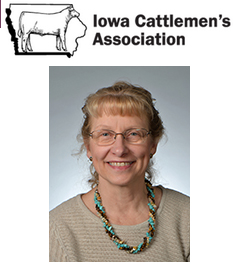Denise Schwab, interim IBC director column

July 2024
It amazes me how pastures could look so bad last fall after three years of drought, and bounce back so quickly this spring with the limited rain we’ve had. As always in Iowa, rainfall has varied dramatically depending on where you live, but I think even the circle of D3 drought right over our farm has finally started to get moisture and look like a normal year. Only time will tell how long the rain keeps coming and how pastures will end up this fall, but the lush green grass now has me thinking about featuring a few of our cow-calf research projects.
Patrick Wall, Erika Woolfolk, Beth Reynolds and myself looked at the impact of creep feeding on Milk EPD’s on 81 spring calving cows at the McNay Research Farm. Cows were 3-5 years old and were grouped into either a high Milk EPD group (HM) or a low Milk EPD group (LM). Calves were given two weeks to get acclimated to the Super SmartFeedTM creep feeder, then both cows and calves were weighed onto test on July 30. Within each milk group, calves were assigned to either no creep, limited intake or ad libitum intake of creep feed. Cows were ultrasound scanned at the beginning and end (October 13) of the trial, and at the mid-point a weigh-suckle-weigh estimate of milk production. Interestingly, a few of the calves in each group did not consume any feed. Calves with ad libitum access had the highest daily gains, with the limit access group having intermediate gains, and the no access the lowest gains. The exception was the LM X no creep calves which outgained the limit access calves, likely due to their dams producing the most milk as measured during the weigh-suckle-weigh. This project supported other research showing that Milk EPD’s are not a direct indication of actual pounds of milk production; however, there are many confounding factors that can impact a female’s milking ability. Ultrasound and visual Body Condition Scores(BCS) both showed little change in the cows’ condition due to creep feed during this time period. The full report can be found here.
In some years we simply don’t have good enough quality or quantity of forages, so how does limiting nutrients to gestating cows impact production? Former IBC graduate student Devin Jakub compared the impact of late gestation nutrition on colostrum quality and cow condition. Forty-eight Angus cows were assigned to one of four rations in late gestation; hay, hay + corn, hay + dry distillers grains, or hay + corn + dry distillers grains. Diets were designed to limit energy, limit protein, limit both energy and protein, or meet the nutrient requirements for the last two months of gestation. Cows were weighed and ultrasound scanned, and a colostrum sample was collected within 24 hours of calving. All cows lost weight, backfat and BCS with no difference between treatments. The hay + corn did not see a difference in ribeye area, however the other three ration groups all lost ribeye area demonstrating the cows pulled energy from their own muscles to support fetal growth. No difference in IgG or total protein in colostrum between groups was seen, however the dry distillers grain diet has significantly high Milk Urea Nitrogen levels due to the excess protein in that ration. It also showed that extra energy was needed to break down the excess protein fed. Surprisingly, the restricted levels of these diets did not result in differences in calf birth weight or vigor, or in calf weigh at 18 weeks of age and weaning. The full report can be found here.
If you’d like to see more details on these projects or other research projects completed at ISU go to the Animal Industry Reports.
The IBC at Iowa State University serves as the university’s extension program to cattle producers. Our center comprises a team of faculty and staff from the College of Agriculture and Life Sciences, the College of Veterinary Medicine and Iowa State University Extension and Outreach. We work together to develop and deliver the latest in research-based information to improve the profitability and vitality of Iowa’s beef industry. If you’d like to be notified of updates on progress of research projects or programs that might be coming to your area, please subscribe to our “Growing Beef” newsletter by following the link on our website, www.iowabeefcenter.org. If you have a question, use our “Ask our Experts” link. Also, feel free to call us at 515-294-BEEF or email us at beefcenter@iastate.edu. You can follow @iowabeefcenter on Facebook, Twitter, YouTube and Instagram.
